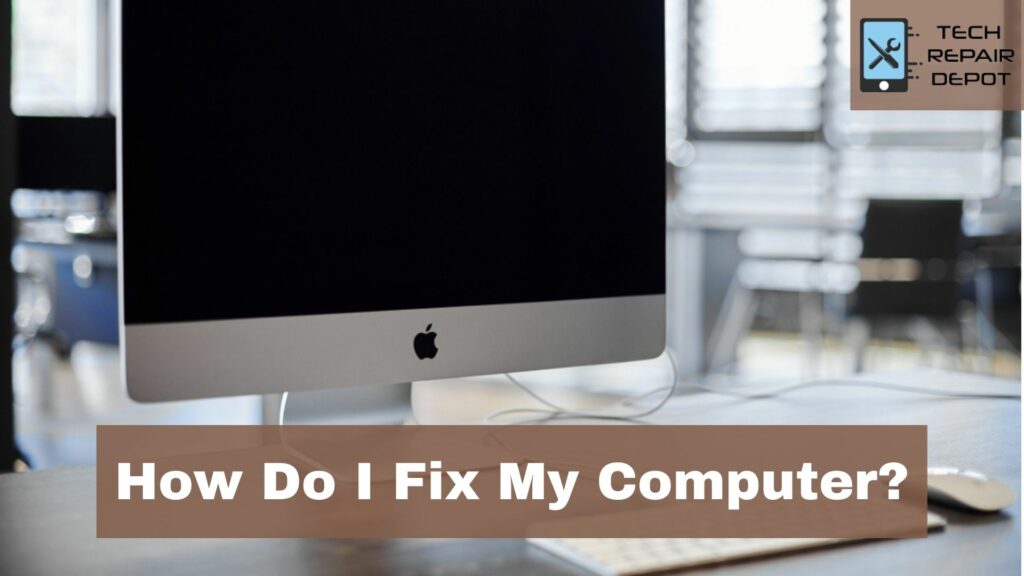
The computer is very useful for our everyday life and our work. It is also a handy tool for entertainment, but it can be frustrating when the computer doesn’t seem to want to do what we need or want it to do. Equipment that has moving parts and generates heat tends to fail most often than not. There are also specific pieces of hardware that malfunction. While most computer problems are easy to fix, some might also go undiagnosed and create more future issues. It is best to know more about your computer issues before sending it over to the repair computers center. This article will answer the most common question: “How do I fix my computer in Montgomery?“
- How Do I Check My Computer for Problems?
- What are the 5 Basic Troubleshooting steps for a Computer?
- Is a 7 Year Old Computer Worth Fixing?
- How Can I Repair My Hard Disk?
- How Much Does it Cost to Replace a Computer Hard Drive?
- Should I Replace Motherboard or Buy New Computer?
- Is it Worth Replacing Desktop Motherboard?
- At What Point Might You Consider Purchasing a New Computer?
How Do I Check My Computer for Problems?
The most frequent problem is a virus or malware infection which causes your screen to freeze up when you try to use your computer. You may also have files that automatically open without your permission or programs that run on their own at start-up time. Other times, there could be different types of issues such as power outages or incorrect cables plugged into the wrong places. One way you can check for viruses is by using an antivirus program on your computer.
You can do the following to troubleshoot your computer issues (e.g slow performance, computer running slow, has an error message, or any internet-related problems). Check your computer’s connection to the power outlet or verify if there is a loose connector somewhere. Make sure that all pins in the connectors are pushed tightly into place. If you’re using an external monitor, remove it from your computer, then turn off the PC before plugging it back in again. You can also try disconnecting any extra peripherals like USB drives or phone chargers and reattach them one at a time while restarting after every change until you find out the problem.
Another way to check your computer for any existing problem is to use diagnostic software to scan the hardware and help you detect any issues. It is vital to back up your data before doing this because there’s a chance it might corrupt during testing. There are many types of issues, but here are some common ones:
- Malware infection that causes screen freezes or unusual programs running on the start-up time
- Power outages or cables plugged in wrong places.
- Loose connectors somewhere in the computer cable connection
- Incorrect settings for network connections (Ethernet) – try plugging into different ports if possible. If not, go to control panel > Network & Internet > Network Sharing Center > Change adapter settings and go to properties to see if drivers are installed correctly.
- Incorrect BIOS or operating system setting – such as wrong time zone, date/time not appropriately set, hard disk partitioning problem
- Operating system not starting up – this is usually due to a virus that has infected the computer’s boot files; you can use antivirus software for recovery, but your data might be lost in the process. If it happens again, then there may be something else going on with your hardware.
What are the 5 Basic Troubleshooting Steps for a Computer?
These are some general troubleshooting rules to follow to resolve certain computer issues:
1) Check the Power
Make sure that the computer is plugged in and turned on. If it’s not, then plug it into an outlet with a surge protector or power strip. If there are any loose connectors, try to fix them by pushing the pins back together and reattaching everything securely. You can also check if your monitor has its own separate electrical cord because this could be causing problems.
Also, make sure all of these connections are tight before turning on the PC again but don’t force anything you’re unsure about. It may take a while for your system to start up, so just relax while waiting; proceed when prompted after 30 seconds or longer. It would be best to watch out for any unusual sounds or lights that seem to be coming from the computer.
2) Reboot the Computer
If you have power and the computer is turned on, but the programs are not working correctly, you can restart the computer. You do this by holding the power button down for a few seconds to completely turn it off and then press it again to start up. Some computers also have requirements such as waiting at least three minutes before turning them back on, while others might take only 20-30 seconds. Most of the issues can be resolve by simply restarting the computer.
You will need to wait about 30-60 seconds before pressing any buttons on your keyboard or inserting any media (such as DVDs) into the CD/DVD drive if you are using one. If there is an issue with these drivers that require updating, restarting may not help even though programs were working correctly in the first place. So be prepared for crashes when attempting this step instead of continuing forward – just remember that everything should work fine after retrying once more.
3) Record Error Messages That Appear
If you cannot fix the computer issue after restarting or if it still doesn’t work even after a few restarts, you should try recording any error messages that appear on your screen. You can do this by taking screenshots and adding them to an email or document for safekeeping.
Be careful not to press any keys while doing so because they may undo what’s already been done in some instances (such as changing settings). The program will usually close once these errors have been shown. But there might be other instances where this isn’t possible such as when files cannot be accessed like earlier mentioned with malware infections. In this case, take care of those problems first before proceeding further.
Once finished documenting the errors, for now, you can boot up the computer and wait for it to show a desktop. You will then have access to everything on your screen, including any open programs, before restarting – such as if one of them was causing the issue in the first place.
4) Update software
In some cases, restarting the computer may not fix anything. You can find out if this is true by updating the software installed on it and then trying to start up again after doing so – sometimes these updates will help resolve issues without actually having to do much else beyond clicking a button or two. The program should prompt you when one of them needs installing, but in other instances, they might automatically install as soon as you connect with an online server (such as Windows Update).
If programs are still showing errors even after updating them, then there could be something wrong with your hardware instead, such as worn-out components inside. This means that replacing those items needs to be done before any troubleshooting steps would work properly because what’s happening is not just a software issue.
5) Check for Malware Infection
Malware, viruses, and trojans can affect a computer’s performance. If you suspect that your computer is infected with one of these, then there are a few things to do to fix the issue. First, scan for viruses using an anti-malware program and see if anything comes up. Second, make sure that all security software is updated as well – such as antivirus programs or firewalls that might show errors themselves after not being used for a while (due to it having been disabled by malware). If they aren’t working properly, then updating them may help. Still, sometimes this can only happen once the infection has been removed first.
Is a 7 year old Computer Worth Fixing?
If it is old and not worth the cost of upgrading, then yes, it might be time for an upgrade. However, suppose it is still working properly, but you just want something newer. In that case, it is recommended to look into getting a refurbished model instead of buying a new one. This way, you are saving money on labor because someone else has already assembled that computer. In some cases, they may have installed all the software, which means less work for you when trying to get started with your newest device whatsoever.
The decision about what should happen will depend significantly on how often people use their computer in general or what tasks need to be done specifically (since these can make up quite different needs). Someone who doesn’t play games or do much more than writing with a word processor may not need as powerful of a computer, but someone who does these things, on the other hand, might be better off getting something that is higher quality.
How Can I Repair My Hard Disk?
A hard disk is a physical disk that stores all your data on your computer. Checks for errors and tries to fix them automatically by re-writing problematic areas with a new file, or it may prompt you with an option to perform a scan on the entire drive (which is used when something like ransomware has been detected). It also looks through files, Windows registry, checks for malware infection, having enough storage space left available – and then fixes any problem if necessary.
Before any hard disk repair attempt, make sure you find out the cause of the problem first. Some of the more common reasons for disk errors are:
- The drive may be dirty or dusty. This means that using a clean cloth to wipe off all visible areas should help resolve this issue – and it may not even require any other steps after doing so.
- It could also mean there is no power going into the computer, which can happen if you didn’t plug in your charger, accidentally unplugged it by mistake, turned off the wrong outlet (electricity), etc. To fix this problem, use an anti-static wristband when touching anything inside or outside of your device and turning on another outlet switch nearby just to see if this fixes things first, before trying other troubleshooting items like restarting again, may do the trick.
- Sometimes when you use a hard disk too much, it will start to develop errors (which can lead to data loss) because of wear and tear – or if there’s not enough space left on this device either, which might mean upgrading that component first before trying other options, so more memory is available for storing files in general as well.
Now you can try fixing the hard disk problem by performing a scan to identify any malfunctioning or corrupted files that should then be repaired.
How Much Does it Cost to Replace a Computer Hard Drive?
Computer hard drives can be expensive, so it is essential to know what size of drive you need before purchasing one. The price depends on the type of model people are using, how old they are (newer models should come with any necessary software programs pre-loaded), and if someone needs additional features such as a more durable SSD. But also will limit their storage space for things like music files or video games because instead, those would have to be stored elsewhere to make room – unless this person opts for something larger such as an external HDD where these could then just sit beside the device itself without affecting its performance whatsoever.
Now onto the prices themselves:
A standard hard disk drive that is 750GB in size should cost around $100, which will double if someone needs a larger capacity to store more data.
For an SSD model with the same GB as mentioned previously, this would be about $145. Since these are generally newer models than traditional HDDs, they also come with Windows installed, so there’s no need for concern over not using their computer right after taking it out of the box because everything is set up beforehand.
Lastly (and usually), external HDD devices typically have prices below either one of those options at just under $80 when shopping online – but may vary depending on where customers purchase from and what features are available. However, it can make sense if people want something like a faster device that might cost more upfront but is worth the extra money to reduce any lagging issues or other complications.
Should I Replace the Motherboard or Buy a New Computer?
After running a scan on the computer to identify any problems, if there are plenty of errors, then this means that it’s time for an upgrade. It is recommended to replace the motherboard first while keeping everything else from before because otherwise, customers will have to buy both parts separately. Which can get expensive and take up more space when putting together a new system altogether – unless they want something larger like an external drive or SSD as mentioned above, so these components don’t directly affect each other in terms of performance at all times either way.
Is it Worth Replacing Desktop Motherboard?
The motherboard is an essential component of your system. It may be expensive to replace it, but it has benefits for hardware support, speed, and better graphics support. Here are reasons you should upgrade your motherboard:
- faster CPU
- faster RAM
- faster data transfer
- better graphics card
- get new or updated features
At What Point Might You Consider Purchasing a New Computer?
If you feel like your current computer is too slow, it may be time to start looking into a new one. In general, users want devices with the latest and most modern specifications available. For example, if they’re using Windows Vista or lower, then upgrading to Windows XP would go a long way towards improving their overall experience – no pun intended. Here are signs that you should buy a new computer:
- Your current computer is incompatible with the new hardware.
- Outdated security
- Your computer is slowing down despite updating it.
- Updates create more issues.
- Repair computers cost more than purchasing a new one.
Summary
To fix most computer issues, you need some troubleshooting knowledge and a little patience while everything gets sorted out. You will want to make sure any loose connectors are firmly in place, for example. And if the power cable has a loose connector, this can be fixed by repositioning it and plugging it back into its respective port. It’s essential to make sure that all of your drivers are up-to-date because these affect how well your computer can run various applications – especially games since they require more resources than other types of software do. You should expect some lagging or slowness when not updating apps or not deleting unused programs. Still, users will see a big difference between before and after right away as soon as everything gets upgraded. Another thing you may want to try is installing an antivirus program on top of what comes pre-loaded with Windows, like Microsoft Security Essentials which is free to download. For more information on computer repair, visit Tech Repair Depot and restore your laptop/computer from its former glory!

